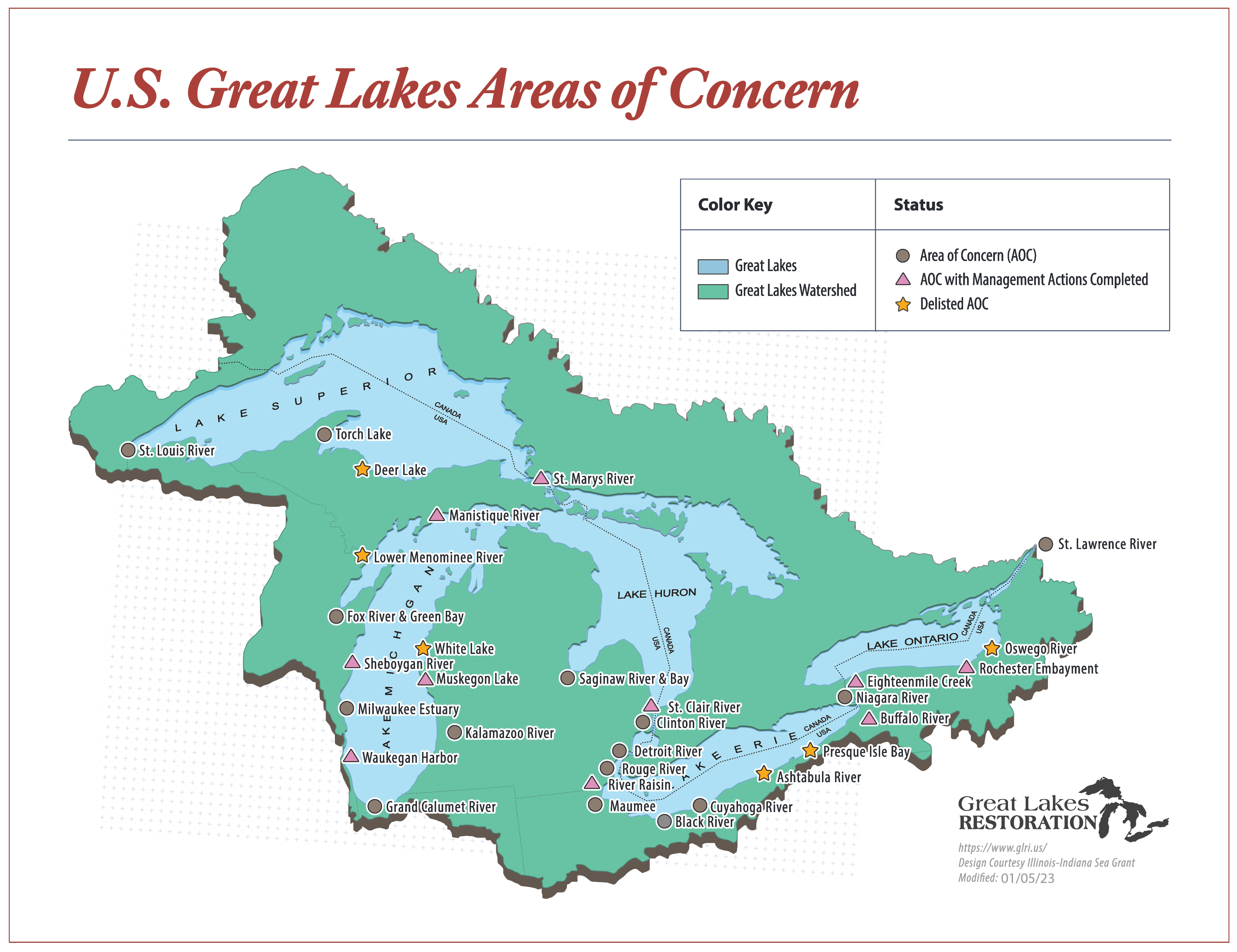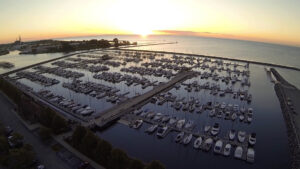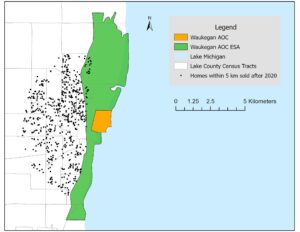July 7th, 2023 by Carolyn Foley
Meet Our Grad Student Scholars is a series from Illinois-Indiana Sea Grant (IISG) celebrating the graduate students doing research funded by the IISG scholars program. To learn more about our faculty and graduate student funding opportunities, visit our Fellowships & Scholarships page. Emma Donnelly is a master’s student in the School of Environmental Sustainability at Loyola University Chicago. Her thesis research is focused on residential mobility and the value of water quality restoration in Great Lakes Areas of Concern.
For decades, legacy pollutants from historical industrial activities have created health concerns for residents in the Great Lakes region. High costs are often a burden in the cleanup process and become a continuous obstacle in tackling water quality issues that affect residents and wildlife. Loyola student Emma Donnelly is conducting research that provides promising insights into the economic benefits of investing in remediation of heavily polluted locations around the Great Lakes. Cleaner water and healthier ecosystems have the potential to expand opportunities for development and recreation, while enhancing local economies and wildlife habitats.

Location and status of the U.S. Great Lakes Areas of Concern. Updated January 5, 2023.
Legacy pollutants, well-known industrial substances, including polychlorinated biphenyls (PCBs) and polycyclic aromatic hydrocarbons (PAHs), not only create health concerns for communities but also threaten the wellbeing of wildlife and limit recreational activities and development of coastal areas. In 1987, the United States and Canada established the Great Lakes Water Quality Agreement in an effort to address concerns about legacy pollutants in the region. This agreement established Great Lakes Areas of Concern (AOCs) to be prioritized for cleanup. Between 1985 and 2019, the United States and Canada spent $22.78 billion restoring AOCs. This has prompted people to ask questions such as: Do the benefits of cleanup outweigh the costs? Might additional cleanup be worth it? Answering questions like these is essential to evaluating the cost-effectiveness of the AOC program.

Waukegan Harbor. Image source: https://www.visitlakecounty.org/WaukeganHarborandMarina.
Waukegan Harbor in northeastern Illinois is one of the 43 AOCs designated through the Great Lakes Water Quality Agreement. Legacy pollutants were first discovered in the harbor in 1975. Since its listing as a Superfund site in 1981 and designation as an AOC in 1987, the Waukegan Harbor AOC has undergone significant remediation. It currently holds the status of “Management Actions Complete,” meaning that all cleanup projects have finished and the AOC is being monitored for delisting.
Over $73 million has been invested in contaminated sediment remediation in Waukegan Harbor. Measuring the economic effects of restoration is essential to understanding the consequences of remediation. In many AOCs, there is a stigma associated with contamination of the water, so remediation of the harbor could contribute to new economic activity in downtown Waukegan. The harbor provides a space for employment at industrial facilities as well as recreational opportunities at public parks and beaches on Lake Michigan, and access to these uses—resulting in economic benefits to the city—can be improved through cleanup.
The goal of Emma Donnelly’s research is to estimate the economic value of restoring the Waukegan Harbor AOC. Her methodology uses an analysis of house sales in Waukegan before and after several milestones of cleanup progress. The analysis relates home prices to property characteristics, including proximity to the boundaries of the AOC. Specifically, in her study, Donnelly examines the effect of the removal of Beneficial Use Impairments (BUIs) on home values. BUIs are water uses that have been restricted because of pollution (e.g., restrictions on recreation and consumption of fish). An AOC is delisted once all of its BUIs have been removed. In the Waukegan Harbor AOC, five BUIs were removed between 2011 and 2020. Only one BUI has yet to be removed—restrictions on fish and wildlife consumption—although it is expected to happen by 2026.

Map of the Waukegan Harbor Area of Concern (AOC) and Extended Study Area (ESA), plus locations of nearby homes that have been sold since 2020.
Donnelly’s analysis provides evidence that local residents value the cleanup of the Waukegan Harbor. The results of the hedonic analysis of Waukegan Harbor indicate that home prices increased by $12,832 per household, or $169 million in aggregate for all households within five kilometers of the AOC.
Donnelly also finds the benefits of the cleanup only emerged after the fifth BUI was removed, suggesting that substantial cleanup may be required before benefits capitalize into housing prices. Her results indicate that the benefits are concentrated in homes approximately 1 to 3 kilometers from the harbor, and that benefits decrease with distance from the harbor. This is consistent with prior research that suggests that the benefits of cleanup diminish for homes that are far from the site of cleanup. She believes one reason why she does not find benefits for homes within one kilometer could be because of the nearby industrial area, highway and railroad surrounding the harbor, which separates homes from the immediate vicinity of the AOC; in fact, there are very few homes located within one kilometer of the harbor. Also, other location characteristics that are part of the industrial setting could have lessened the effect of the cleanup on home prices. Overall, Emma’s findings may suggest that for industrial areas with degraded water quality, where households are not located immediately adjacent to the water, substantial progress toward full restoration may be required before benefits start to capitalize in home values.
Sources:
Thirty-five years of restoring Great Lakes Areas of Concern: Gradual progress, hopeful future – ScienceDirect
Waukegan Harbor AOC | US EPA
Waukegan Harbor Remedial Action Plan. Final Stage III Report – Waukegan Harbor RAP – July 1999
Illinois-Indiana Sea Grant is a partnership between NOAA, University of Illinois Extension, and Purdue University Forestry and Natural Resources, bringing science together with communities for solutions that work. Sea Grant is a network of 34 science, education and outreach programs located in every coastal and Great Lakes state, Lake Champlain, Puerto Rico and Guam.
Contact: Carolyn Foley
September 12th, 2016 by iisg_superadmin
Shrimp is the number one seafood consumed in the United States, and Indiana, of all places, is a leader in inland shrimp farming. One reason is that Kwamena Quagrainie, IISG aquaculture marketing specialist, is providing these producers with practical information on how to maximize their profits.
Quagrainie studied the economics of raising Pacific white shrimp indoors and found that turning a profit can depend on being a little patient.
“Because demand is high, the temptation is to sell smaller shrimp. But if the producers wait until the shrimp are bigger, they can charge more,” he said. “The value you can set by growing them to a larger size far out ways the cost.”
His study revealed that marine shrimp are more profitable if grown to at least 26–30-count per pound.
It also pays to wait until the shrimp are bigger before moving them from the nursery to the growing tank. This can help boost the survival rate.
Indiana has 11 shrimp farmers in the state who sell their product on-site directly to consumers or to nearby restaurants. “People are looking for food that is fresh and the shrimp market has benefited from the local foods movement,” said Quagrainie. Although, the majority of shrimp consumed in the U.S. is imported from farms in Southeast Asia, Ecuador, and Mexico.
In addition to IISG, this study was funded by Indiana State Department of Agriculture as well as from Purdue Extension, and Indiana Soybean Alliance, and in partnership with the Indiana Aquaculture Association Inc.
Illinois-Indiana Sea Grant is a part of University of Illinois Extension and Purdue Extension.
August 10th, 2016 by IISG
Lauren Schnoebelen interned in Chicago with IISG Water Resource Economist Margaret Schneemann. Lauren is a recent graduate from Northern Michigan University with a major in environmental science, a concentration in natural resources, and a minor in sustainability.
This summer I spent my time working as the Water Policy and Pricing intern for IISG at the offices of the Chicago Metropolitan Agency for Planning. I didn’t really know what to expect. I was excited to work on policy issues and get familiar with township and village ordinances for water pricing, but I had never worked with large data sets before.
At first I was a little overwhelmed, but once I started getting the hang of it, I really enjoyed it because I got the opportunity to see what so many communities around me were doing to manage their water systems. After working for a month and a half on collecting as much data as I could get on water, sewer, and possible storm water rates, I needed to call village halls and water facilities to get any missing information.
The hope was to have all the rates available for the 2017 fiscal year. This gave me the opportunity to improve my communication skills by talking to dozens of people about what they charge their residents for water and sewer services. With this project done, I’m really excited to see how the final presentation of it will be in the Northeast Illinois Water and Wastewater Rates Dashboard.
Another opportunity that I was given was becoming a co-author of a published literature review. I helped to write about the economic value of ecosystem services in the Great Lakes region. This project allowed me to create and organize multiple tables displaying all the studies that were used in the paper and write summaries based on their subcategories of threatened ecosystem services. I also helped in editing and arranging the final layout of the literature review.
Throughout my summer, I was going to monthly meetings for the Northwest Water Planning Alliance and was involved in creating a community outreach brochure on establishing new lawns through seed or sod and their water requirements. This helped me see what communities are currently doing to work on water conservation and also how community outreach can lead to suggestions for policy change.
This internship gave me an opportunity that I haven’t had before. I worked on so many different aspects of water conservation which gave me great experience in creating a database, academic research and writing, and community involvement and outreach. With these skills, I know I will be extremely competitive in finding a full-time position in my field.
Illinois-Indiana Sea Grant is a part of University of Illinois Extension and Purdue University Extension.
February 11th, 2015 by iisg_superadmin
We talk a lot about the environmental benefits of sediment remediation. These are hard to miss—a trip to the river or harbor is often all it takes to confirm that the aquatic habitat is on the mend. The role of cleanup projects on local economies can be harder to pin down, but the impacts are just as striking. Brandon Steppan, IISG’s new communications intern, has the story.
I’ve lived in the city all my life. With the exception of a few parks and forest preserves, I never really saw environmental health as being all that connected to the welfare of my community. The only rivers that ever made the news were the Chicago River on St. Patrick’s Day and the Des Plaines River whenever it flooded—especially if that meant Gene and Jude’s, an iconic hot dog stand in River Grove and arguably the best place to get a Chicago-style hot dog, would have to shut down for repairs.
What I’ve learned about other Great Lakes communities in the short time I’ve been with IISG has already made me reevaluate just how valuable a healthy river can be—not just in terms of environmental integrity, but in dollars and cents. Results of economic studies of Great Lakes Areas of Concern (AOCs) have listed the values of what a clean waterbody would be for those communities, with numbers ranging from $6 million for one small neighborhood to $19 billion for all 31 original AOCs in the U.S. To get these numbers, economists and social scientists looked at money brought in from tourism, real estate values, and residents’ willingness to pay for a cleaner waterway.

One of the more remarkable returns came from a 2004 examination of the Waukegan Harbor AOC in Illinois. An analysis of housing data and resident perceptions determined that proximity to the PCB-ridden harbor substantially drove down property values. When surveyed, Waukegan homeowners revealed they would be willing to pay more for their property if it meant full cleanup of the harbor—a collective value of $436 million, much more than the projected cost for remediation.
My initial reaction to these reports was a mixture of confusion and surprise. But as I took into account the number of people in each area and how they rely on their local rivers not just for livelihood but for quality of life, the numbers no longer seemed all that surprising. The hazards of a toxic river bed aren’t always obvious, and unfortunately, neither are the benefits of remediation. Having these numbers available helps create a conversation where those benefits are no longer vaguely environmental, but economically tangible.
***Photo from the Waukegan Port District.
January 21st, 2015 by iisg_superadmin
A closer look at web tools and sites that boost research and empower Great Lakes communities to secure a healthy environment and economy.
.png) Aquaculture plays an increasingly vital role in securing long-term food supplies, and the Midwest is poised to help. In fact, a rich supply of raw materials and proximity to large markets makes Illinois and Indiana prime locations for aquaculture farms and related industries.
Aquaculture plays an increasingly vital role in securing long-term food supplies, and the Midwest is poised to help. In fact, a rich supply of raw materials and proximity to large markets makes Illinois and Indiana prime locations for aquaculture farms and related industries.
To help producers cash in on these benefits, IISG, University of Illinois Extension, and Purdue Extension teamed up to create Aquaculture Economics and Marketing Resources. The site provides leading research and how-to information for developing a productive, innovative, and profitable aquaculture business.
Visitors interested in starting a new business will find resources on everything from establishing an organizational structure to creating a business plan to securing financing. New and veteran producers can also find tips for connecting with consumers and tapping into niche markets.
Aquaculture Economics and Marketing Resources is one of several tools IISG uses to help aquaculture producers define markets and create value-added opportunities for their products. Since 2005, Kwamena Quagrainie has held roughly 40 workshops with over 1,200 participants. These and other efforts in Indiana resulted in about $15 million in farm sales of aquaculture products in 2013, a nearly five-fold increase over 2005.
To learn more about how aquaculture is strengthening Indiana’s economy, read our 2013 program impacts.





.png)
